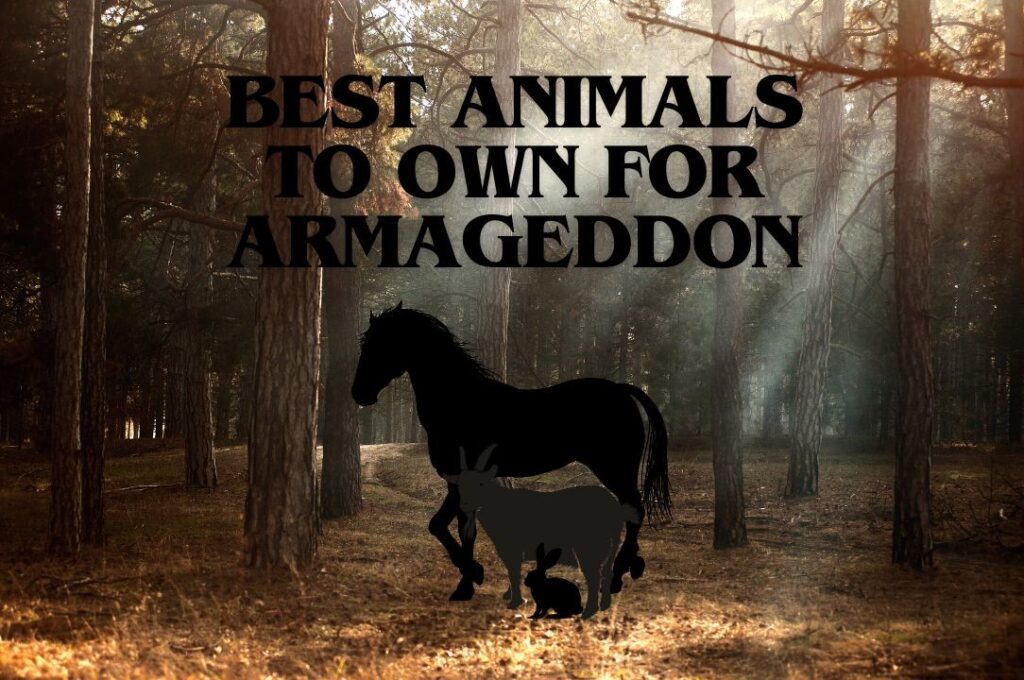
On The Job 4.jpg
Prepping is all the rage and is here to stay. It comes under different labels . . . prepping, self-sufficiency, homesteading, emergency preparedness . . . they are all very similar and come down to survival of the most skilled and best prepared. When we started our homestead, we had self-sufficiency in mind. So much so that we got set up with animals before getting our own house built first . . . big mistake. We don’t make a whole lot of money and the additional financial burden of animals didn’t help. It came down to downsizing, learning, and trying again.
Before getting started with ANY animals. Understand that those animals are your responsibility. Their health and wellbeing falls on you. Even if some of the animals are being raised for meat, they need to live humane healthy lives up until then. Take care of them, they are taking care of you.
Breakdown Of This Post
First Things First
-Time
-Know Your Neighbors
-Climate
-Space
-Shelter
-Food
-Water
-Protection
-Different Breeds
-Vet Care
-Waste Disposal
-State Laws
Best Animals For Armageddon
-Dogs
-Bees
-Chicken
-Ducks
-Heritage Or Wild Turkey
-Coturnix Quail
-Rabbits
-Goats
-Horses
What About These Animals?
-Cattle
-Guinea Fowl
-Fish
-Pigs
-Cat
Alternative To Raising Animals
-Befriend Your Neighbor
-Learn To Hunt
-Store/Preserve/Prepare
-Craigslist
Conclusion
First Things First
Before getting started there are some things you need to consider before getting started with animals . . .
Time
Caring for animals takes time. And if the apocalypse happens, you’re going to have a lot of time. Tasks will include cleaning up poop, feeding, watering, maintaining enclosures, butchering, milking, cheesemaking. The more animals you invest in, the more time it will take. Do you plan to stick it out on your property? Or do you have bug out plans? How much time to you want to take with raising animals’ vs hunting.
Know Your Neighbors
How well do you know your neighbors? In the event of an apocalypse are they still going to be friends, or a marauding foe. Becoming self-sufficient is great for you. But only if you can protect what you’ve worked towards. Raising animals, unfortunately, puts a target on you back to those around you. Ideally you can conceal what animals you’re raising to make you less of a target. But that can be a challenge depending on where you live, the animals you choose to raise, and how nosy your neighbors are.
 Climate
Climate
Do you live in a harsh environment that will make raising animals more naturally difficult? How much natural forage is there? How many pests and disease potential are there for your animals. For instance, the further east you go there’s more lush land, but there is also an increased risk of ticks and fleas affecting your animals. The desert has less pests but is also not as rich in natural forage. We’ve considered ourselves lucky to be somewhat in the middle with that. But it’s not without other complications. In the Colorado mountains we get lush forage without excessive pests, but it comes and goes quickly with the long winters. When picking out an animal to raise, you need to choose something that will naturally thrive in your area.
Space
Unless you have an incredible storage for animal feed (which will eventually run out). You need space to raise animals. If your property isn’t that big. Then it would be beneficial to live near grazable land to take your livestock animals too. But this would also open you up to marauders that are up to no good. If you don’t have the land to feed you animals naturally, you might want to reconsider raising any.
Shelter
All animals need some sort of shelters. The colder or more susceptible to predators you are, the better the enclosures need to be. For us living on a mountain in the cold Colorado mountains with bears, cougars, foxes, raccoons, hawks . . . our animals require secure enclosures and shelters to stay safe.
Food
Ideally you can pick animals that can survive naturally off your land without too much assistance. Generally, most animals benefit from some sort of supplemental feed or input, especially in Winter. So, it’s ideal if you have the space to be able to stock up on hay, feed, straw, and mineral supplements.
Water
Nothing lives without water, and I doubt many people have the ability to store enough water for both themselves and their animals. So, having a nearby natural water sources is a must.
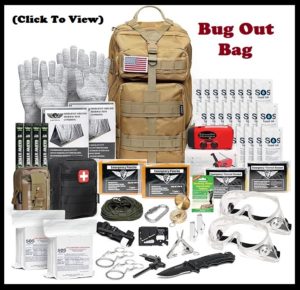 Protection
Protection
We’ve partially already covered this. But are you able to keep your animals safe. Find out what predatory animals you may have to deal with in your area. And are you going to have the ability to either keep the fact you’re raising animals quiet from troublesome neighbors? Or do you have the ability to keep those animals safe in the event you do become a target.
Different Breeds
Not all breeds are the same. Some breeds are not as healthy as others. Some require more feed than others. And some have more or less desirable traits than others. With any animal you’re after, choose the one that is best suited for the hypothetic potential that life gets rough.
Vet Care
You need to consider that a vet may not be an option if one of your animals gets sick or injured. It’d be in your best interest to begin learning about the animals you’re intending on getting. Find out what some of the common issues are and purchase helpful books. Also figure out what the best kind of first aid kit are that you need to put together and stock up on supplies.
Waste Disposal
All that animal waste has to go somewhere. If you have enough land, then it may not be an issue. But if you are going to be finding yourself mucking out stalls and such you will want to figure out where all of that waste is going to go. Ideally you can compost it and turn it into some great fertilizer for your garden and crops to grow.
State Laws
State laws won’t matter when shit hit’s the fan. But until then there are certain rules to follow in order to own animals. You don’t want to get into trouble and have them removed. Find out what your property is zone for to find out what animals you can or can’t have.
Best Animals For Armageddon
(Not In Any Particular Order)
 Dogs
Dogs
Ability To Survive Independently – ★★★★★
Land Requirements – Minimal, they live where you live
What They Need – Meat/kibble, water, proper training
What The Provide – Protection, rodent control, hunting, alert system, companionship, herding
Productive Years Of Each Animal – 7-10 years old (but can live up to 12-14 years)
I don’t think I need to tell you that dogs have been and will always be man, and womens’, best friend. Dogs that have been abandoned in other countries have proven that they can form packs and survive on their own. If you’re looking for the best breed to make it through the apocalypse with you there are a few things to consider. You may think you need a big strong dog for protection. This could be true, but a big dog also requires a lot more resources and is more susceptible to health problems.
With this in mind you’ll want to pick a dog that is more midsized. Besides being a loyal family companion, you also need to consider what job you need your dog(s) to do. This can include things like hunting, ratting, security, flock protection, etc. Though certain dog breeds have natural abilities to certain jobs. Training is a must to teach them how to their job well. Depending on the breed and the tasks you need them to complete, they begin to slow down anywhere between 7-10 years old. Though good healthy dogs should continue to live until 12-15 years of age. Get your dog(s) used to eating raw and they will be able to survive off of leftovers like discarded carcasses from butchering. While you can, stock up on some healthy freeze dried or dehydrated dog food so fido can be fed in between kills.
WANT TO KNOW MORE? See The Top 5 Best Survival Dogs In This Post Here.
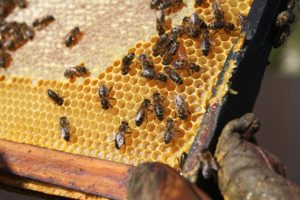 Bees
Bees
Ability To Survive Independently – ★★★★★
Land Requirements – Minimal
What They Need – Water, flowers, supplemental food in times of scarcity
What They Provide – Honey, wax for candles
Productive Years Of Each Animal – Several years for a healthy hive
Bees are essential for human survival whether were in an apocalypse or not. They pollinate crops that provide us food. In addition to providing honey, you can get wax for candles, royal jelly, propolis, and venom. Yes, studies have found that bee venom has anti-inflammatory, antioxidant, central nervous system inhibiting, radioprotective, antibacterial, antiviral, and antifungal properties, among other things. People with arthritis, nerve pain, and MS have been treated with venom to ease their pain. The treatment is called apitherapy.
It’s important to note that bee keeping is no easy task and often requires a great deal of knowledge to keep the hive healthy and free from attacks by other bees, mites . . . Modern day pesticides have also had a detrimental effect on many beekeepers’ hives. Certain varieties of bees survive better in certain climates. So do the research to see what will do best in your area.
Bees generally travel within 1 mile of the hive. But can fly up to 5 miles away in search of food. Though bees tend to produce more honey than they need to survive. Special care needs to be taken so that you don’t take too much. Otherwise, they will require supplemental feed in order to survive winter. It’s good to find out beforehand whether or not you’re allergic to bee stings or have a severe, it not potentially deadly, reaction. You can’t just go to the hospital during an apocalypse to get it taken care of. But if you can master beekeeping, they could make a great food source and bartering tool.
 Chickens
Chickens
Ability To Survive Independently – ★★★★☆
Land Requirements – About 50 birds per acre
What They Need – Oyster shell, minimal feed or food scraps to keep them close to home, protection from predators, coop
What They Provide – Meat/Eggs/Feathers
Productive Years Of Each Animal – Optimal years for eggs production is roughly 3 years before it begins to decline.
Chickens have been around for ages. Even throughout the depression. Chickens foraged for themselves with the occasional handouts of grain. Back then they didn’t even have coops and the chickens would sleep wherever they could find a safe spot. Often times they slept in the barn with the other animals. Everything wants to eat chickens so take care to protect them from danger.
Ideally you can grow a chicken garden of sorts like sorghum, amaranth, millet, sunflowers, greens, herbs to assist with feeding needs. Raising bugs would also be a plus. We haven’t gone to that extent yet. But crickets are abundant in our area if we wanted to raise them. So, for chickens you mainly need land, supplemental feed, protection, and depending on your set up a coop is generally ideal. A coop is a must for us as our dogs are indoor dogs and we get raccoons, skunks, and foxes.
Breed is also an important consideration. You’ll want to avoid the meat breed birds as they require more feed. I’d even question the popular dual-purpose breeds. If you have the resources to support dual purpose birds, then I highly recommend them for both meat and eggs. The most popular being Orpington, Australorp, and Speckled Sussex. But if you want the extreme survival chicken, you’ll want the lighter weight breeds that are able to evade predators better.
The best breed I’ve found that fits this bill is the Brown Leghorns. They are more of a flighty bird, but this makes them great at escaping predators and they have a fantastic feed to egg ratio. Another great one is Easter Eggers which are a bit more friendly. However, they don’t tend to go broody. Silkies don’t have the best survival skills but are the optimal breed to use if you are interested in hatching eggs. They are known for going broody incredibly easy. Muscovy ducks are also popular for egg hatching.
*Cackle Hatchery has been a great hatchery I’d recommend. They actually have a “Free Range/Predator Resistant” package of chicks you can buy. It potentially includes breeds like the Brown leghorn, Easter Eggers, Egyptian Fayoumis, Red Jungle Fowl and Old English Standard Game Fowl.
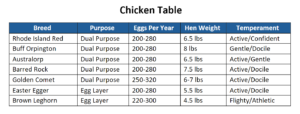
WANT TO KNOW MORE? Raising Chicks With Very Little To No Power Post HERE.
 Ducks
Ducks
Ability To Survive Independently – ★★★★☆
Land Requirements – 20-40 birds per grassy acre, 8-15 birds per pond acre.
What They Need – Water, protection from predators, supplemental feed, coop
What They Provide – Meat/Eggs/Feathers
Productive Years Of Each Animal – Optimal years for eggs production is roughly 3 years before it begins to decline.
Ducks are a popular choice for preppers as they are surprisingly tough. Adapting to both hot and cold environments. I rated them 4 our of 5 stars as most farm ducks are too heavy to fly which makes them more susceptible to predators. Just like chickens they can produce eggs every day of the year thorough their lives. The most productive years being 3-5 years. Duck eggs are generally larger than chicken eggs with a longer shelf life. Ducks don’t have to have a pond but would greatly enjoy it. Domesticated ducks tend to be larger and therefore are generally too big to fly. They love to hunt for worms and snails and will even go for frogs and snakes. They don’t lay eggs in a nesting box. But providing a nesting area at ground level suits these guys just fine.
Heritage Or Wild Turkeys
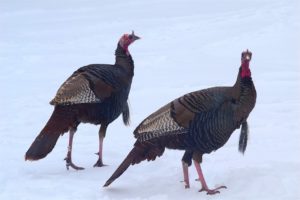 Ability To Survive Independently – ★★★★★
Ability To Survive Independently – ★★★★★
Land Requirements – 20 birds per acre
What They Need – Ideally a daily food ration. But at the very least some sort of daily food handout to keep them sticking around your home. Proper roosting areas to keep out of reach of predators.
What They Provide – Meat/Feathers
Productive Years Of Each Animal – Ready to breed at 1.5 years of age. Hens are productive for 5-7 years, 3-5 for toms.
Here in Colorado, we have wild turkeys. If you live where wild turkey’s do well. Then it would be in your best interest to also raise them. NOT BROAD BREASTED TURKEY’S. Broad breasted varieties are unnaturally large and would not survive on their own. They are bred through artificial means and need a lot of supplemental feed to live and grow. Find a good heritage turkey with natural coloring to use as camouflage. Turkey’s raised from babies learn to stick around like big feathered dogs.
Enough land is needed for them to forage and find food. And the daily hand out of some sort of grain or kitchen scrapes will keep them from wandering too far. You don’t even need a coop. Just a way for them to perch high off the ground from predators at night and have some level of protection from the elements. Our turkeys would roost in the pine trees. Any that were dumb enough to stay on the ground because they couldn’t find anywhere to perch would get picked off by foxes. This is where it became an evening task for us to ensure that they all found a place up high at bedtime. This worked well and we just harvested as needed. They hit butchering age at about 7-8 months old.
WANT TO KNOW MORE? Which Breed Of Turkey To Get post HERE.
 Coturnix Quail
Coturnix Quail
Ability To Survive Independently – ★☆☆☆☆
Land Requirements – Minimal
What They Need – Suitable housing, food, water, incubator/brooder for hatching/raising chicks, protection from predators
What They Provide – Meat/Eggs
Productive Years Of Each Animal – 1-2 years
I feel like quail get overlooked as a survival animal. The biggest downside to them being a doomsday animal is that they are heavily reliant on people to survive. They’ve been so heavily domesticated that they lack the skills needed to survive long in the wild on their own. They must be housed in fully enclosed pens. They will not stick around and free range like chickens and are much more at risk for predators.
But with the right set up and if your able to produce natural foods (seeds, bugs, berries) these birds have great potential to provide you both eggs and meat. The benefits may outweigh the negative. They are hot and cold hardy, small, quiet, quick to mature at 7-8 weeks of age, easy to process, prolific egg layers, have very nutritious meat/eggs, and have simple housing requirements. As long as temperatures are at about 60°F or above, they will lay about an egg a day.
Nesting boxes are not needed as they tend to lay their eggs just anywhere. The best way to do quail is to be breeding them for a steady supply. And with quick maturity comes quick aging. Breeding adults are only good for 1-2 years before you need to swap them out. So it’s good to have enough birds for genetic diversity. You typically want a male per 5-6 females to ensure good fertility. With the right set up I think these birds would make a fantastic doomsday addition.
Rabbits
 Ability To Survive Independently – ★★★★★
Ability To Survive Independently – ★★★★★
Land Requirements – Minimal, 1/4-1/2 acre
What They Need – protection from predators
What The Provide – Meat, Fur, Cold Manure, Dog Treats?
Productive Years Of Each Animal – 4-5 years
Rabbits may just be the #1 best source for a lot of meat fast. Two does to a male is said to produce what a cow would give you in 1 year. The most productive breeds that tend to have large fast-growing litters include New Zealands and Californians. There are several other meat breeds but those are the most well-known for best production. Does must be bred at least twice per year (up to 6x’s per year) in order keep producing larger litters. Ideally you have a lot of pasturelands and can make rabbit tractors to move your rabbits around and they can graze naturally.
Winter could be a problem so it’s ideal to have hay storage as back up. Alternatively, if you don’t have hay and can’t get it then it’s on you to cut and dry plenty of meadow grass yourself when the weather is good, and things are growing. Rabbits need variety and can also eat clover, twigs, roots, bark, pinecones, leaves, bushes, etc. Identify the plants in your area and find out which ones are safe vs toxic so you know what you can feed your rabbits. You can also grow your own rabbit garden with a variety of greens and beneficial herbs. Alfalfa is great for growing babies and nursing mamas with its higher calcium and protein content.
Rabbits are also great for producing “cold” manure for the garden. This means it can be directly added to your garden and not burn your plants unlike the other animals that produce “hot” manures that must first be composted before using. Another odd thing I’ve heard for rabbit poop is that you can feed their droppings as “treats” to your dog. Not the urine-soaked ones. But you can dry the regular ones as vitamin rich treats. Personally, I wouldn’t recommend feeding your dog rabbit poop. Looking into it, it doesn’t look like it’s a major health concern provided the rabbit is healthy and not eating something toxic that could transfer to your dog. But in a situation in which food options are scarce, it’s something to consider.
WANT TO KNOW MORE? Guide To Raising Meat Rabbits Post Here.
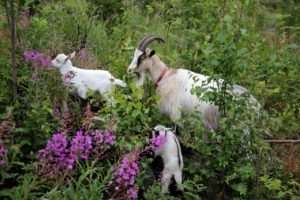 Goats
Goats
Ability To Survive Independently – ★★★★★
Land Requirements – 1-4 goats per acre depending on breed and land sustainability.
What They Need – Possible copper/selenium supplements depending on native soils, occasional hoof care, protection from predators
What They Provide – Milk, Meat, Cheese, Soap, Weed Control, Lard for cooking and candle making
Productive Years Of Each Animal – 10+ years
I’ve rated these guys at 4 out of 5 stars as for the most part they have the potential to fully survive on their own. However, depending on the area, they will be at risk for predatory animals. If the natural forage and soil is poor in copper and selenium, then a supplement may be necessary. Goats tend to versatile and provide many products for your family from meat, milk, cheese, soap, etc. If you opt for the larger milk breeds, they are commonly used as pack goats to go hunting and carry the kill home. This makes them a wonderful asset for any prepper type situation.
You can bond with bottle baby goats so they will want to stay close to home like dogs. One of my favorite things to do is go hiking with my goats. They are often easier to walk than the dogs. Where the dogs will want to go chase deer and such. The goats stay close and just stop to graze when I decide to stop. It’s very peaceful. But I do need to keep an eye out for danger like off leash dogs or cars. My goats trust me, so they don’t spook easily and follow my lead.
WANT TO KNOW MORE? Different Goat Breeds & Their Uses Post HERE.
Horses
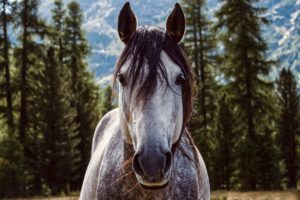 Ability To Survive Independently – ★★★★★
Ability To Survive Independently – ★★★★★
Land Requirements – 2-4 acres per horse.
What They Need – Hoof care, large enough grazing area, supplemental grain if they are being ridden a lot
What The Provide – Ability to travel and hunt more effectively
Productive Years Of Each Animal – 20+ years
Now putting horses on this list doesn’t mean just any horse. You’ll want a horse that’s still in touch with its wild roots like the mustang. Mustangs are built to survive with good food conversion and tougher hooves. These guys have been known to survive off of tree bark during harsh winters if need be. As horses are herd animals and like the company of their own kind. It’s ideal to have at least two. If you have the land to support a couple of horses, then that will greatly benefit you and your ability to successfully hunt by increasing how far you can search for game.
If you are buying an older horse, it’s essential to have a vet look them over and do a blood test to make sure they are medically sound. Sellers often try to disguise any medical or behavioral problems with the horse through drugs and lies. A horse also needs to be large enough to be able to comfortably carry you. You and your tack need to weigh no more than 20% of the horse’s weight.
A horse is also no good without good feet. You’ll want a barefoot horse (no horseshoes) and learn how to trim their feet yourself. If a horse you want to buy already has shoes, it’s possible to wean them off and get them to barefoot status. Studies are finding that horseshoes are really not the best on your horse’s feet. They were first introduced back in the old days when horses were the main mode of transportation and traveled unnaturally long distances that wore their feet down to the point of going lame. Anyway, learn from an experienced farrier how to trim horse hooves as it doesn’t take much to make a horse go lame from doing it incorrectly. If a horse is getting adequate exercise, then the need for hoof care will be less frequent.
What About These Animals. . .
Cattle
Cattle are just too big to be worth it when goats provide everything that cows do on less land and feed. Cows are grazers and specifically require pastureland and a lot of it. Whereas goats are browsers can survive on less pasture, bushes, tree bark, weeds, and other browse.
Guinea Fowl
Guinea fowl are great survivors as they have the ability to fly and are great at eating things chickens might miss such as ticks. However, they are incredibly loud throughout the day, don’t lay that many eggs, they are not the greatest mothers for raising chicks. They can provide meat but it’s just not as efficient as the other options. Guineas grow more slowly than chickens.
Fish
If you are lucky enough to have a natural resource for fish like a pond, river, or stream. I’d encourage you to figure out how to use it to your advantage to raise fish. But the majority of people don’t have that. And it’s not worth it to set up such a system. It requires building a system and having a steady supply of water to put back into the system as it slowly evaporates over time. The fish will also need to be fed. It’s just not worth it in most cases. Aquaponics are great systems. But if doomsday happens, you can’t get what you need to keep the system going properly unless you have a natural water source and fish food source.
Pigs
Pigs were a tough one, but they did not make the list due to the following reasons. They are difficult to contain animals and can dig, they can’t survive on just grass, they require water and mud to keep cool in the heat, pigs are so closely related to people that the potential for diseases to transfer is high, rooting behaviors cause damage to the land, they are escape artists, and they are not very winter hardy without plenty of bedding.
I know somebody is going to bring up Kune Kune pigs or other pasture pigs. Pasture breed pigs are still omnivorous and do best with supplemental feed. And though they have smaller snouts, they have still been known to root around. If you have a unique productive way to raise pigs naturally then I encourage you to explore that option. But ultimately, I don’t think they are an obvious choice to raise in a doomsday situation.
Sheep
I’ve heard enough problems with raising sheep that’s it’s just not a wise one to attempt. They seem to have unique nutritional needs, be highly susceptible to intestinal parasites, and they are more of a skittish farm animal. I’ll admit I haven’t raised sheep myself or looked into them much. Maybe there’s a best breed that would be suitable to raise. But on the surface, they seem more high maintenance and risky than some of the other choices. And this post is about the best animals.
Cats
Cats are great on a typical homestead if you have mice. But in a survival situation they are not really a necessity. As long as there is a natural supply of rodents, then they should be able to survive on their own. Supplemental feed for winter is ideal. In the event that you have to bug out and leave home. A cat would not travel well and would sadly be abandoned. For us, we have mice, chipmunks, and a few rats. But it’s nothing that a few regularly managed rat and mouse traps can’t handle. So for us a cat isn’t necessary. We mostly rely on properly storing feed to lessen any pest problems in the first place.
Alternative To Raising Animals
Befriend A Neighbor
There’s something to be said about strength in numbers. If you have a neighbor that also shares your mentality of emergency preparedness and has a better ability to raise livestock. Combine forces and make plans on how to work together and share the load with each other for if the shit hits the fan.
 Learn To Hunt
Learn To Hunt
Hunting is a skill, and a valuable one at that if there ever comes a time to put it into action. Seek out training courses, videos, and books to gain some books smarts. Then when you feel ready to put that knowledge into action, try joining hunting/sporting clubs to seek out other hunters you could join on hunts. Sometimes other hunters are looking for someone to mentor.
Store/Preserve/Prepare
Start building your food stores before something happens. It’ll ensure your family is prepared and give you a head start on a very important skill. Things like canning can be dangerous if not done correctly. So become good at it ahead of time. Other preservation methods include making jerky, freezing, pickling, freeze drying, fermentation, and curing.
Craigslist
Buying meat for preservation can be expensive unless you find a great way to get it in bulk like meat shares. Another great source that also provides a learning experience is to buy cheap animals on Craigslist. You can often times find perfectly good livestock going for really cheap. This not only provides an opportunity for getting a hold of meat that is probably better than the factory fed meat from the store. But also provides a fantastic opportunity for you to learn how to process an animal yourself.
Find out whether or not you have the stomach to dispatch an animal (humanely as possible). Which is something you’d have to do in a survival situation anyway. Discover which parts of the animal you need to salvage and which parts to discard (liver and other organ meats are a nutritional powerhouse). Give your dogs the opportunity to investigate what it is to eat a carcass like their ancestors. I know this sounds really barbaric and grizzly but it’s how things used to be done. Everybody is used to convenience and not having to take part in how meat gets from the animal to their plate. It gives you a whole new appreciation and respect for things.
Conclusion
Would you agree with this list? Or is there an animal I missed? I’d love to hear about it. In my experience it’s best to dabble in several options for optimal survival. So in my opinion . . .
-A dog is a must for companionship, deterrent for predators and marauders, hunting, protection, and an early alert system.
-You need food storage to get you by while you grow a garden, raise animals, or for in between hunts.
-If you have the land and resources for animals to thrive naturally, pick at least 2 animals to raise for a food source.
Recommended Books (clickable)
Source:
Therapeutic Use of Bee Venom and Potential Applications in Veterinary Medicine – PMC (nih.gov)
Source link
2024-02-28 23:40:48
Originally posted 2024-07-02 10:59:35.
Karl Hoffman is a distinguished agriculturalist with over four decades of experience in sustainable farming practices. He holds a Ph.D. in Agronomy from Cornell University and has made significant contributions as a professor at Iowa State University. Hoffman’s groundbreaking research on integrated pest management and soil health has revolutionized modern agriculture. As a respected farm journalist, his column “Field Notes with Karl Hoffman” and his blog “The Modern Farmer” provide insightful, practical advice to a global audience. Hoffman’s work with the USDA and the United Nations FAO has enhanced food security worldwide. His awards include the USDA’s Distinguished Service Award and the World Food Prize, reflecting his profound impact on agriculture and sustainability.
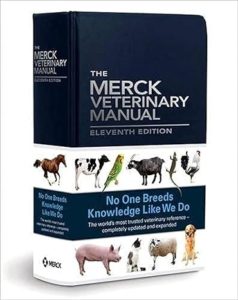
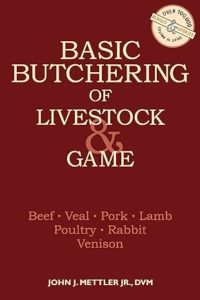
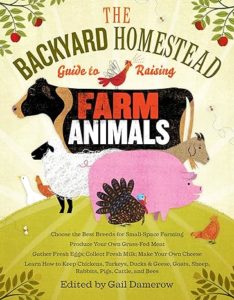
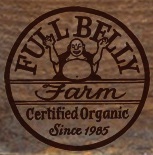



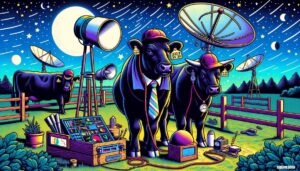

Farm Radio’s live broadcasts from local fairs are my favorite. Makes me feel like I’m right there!